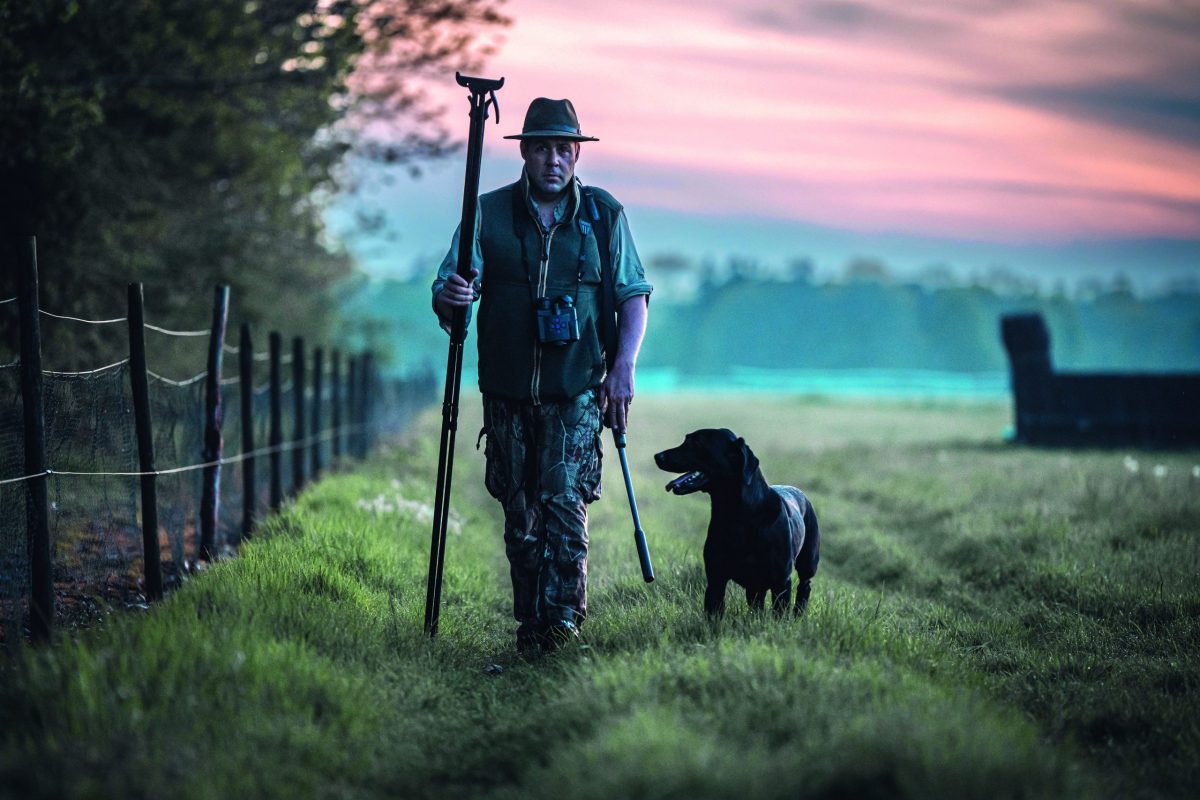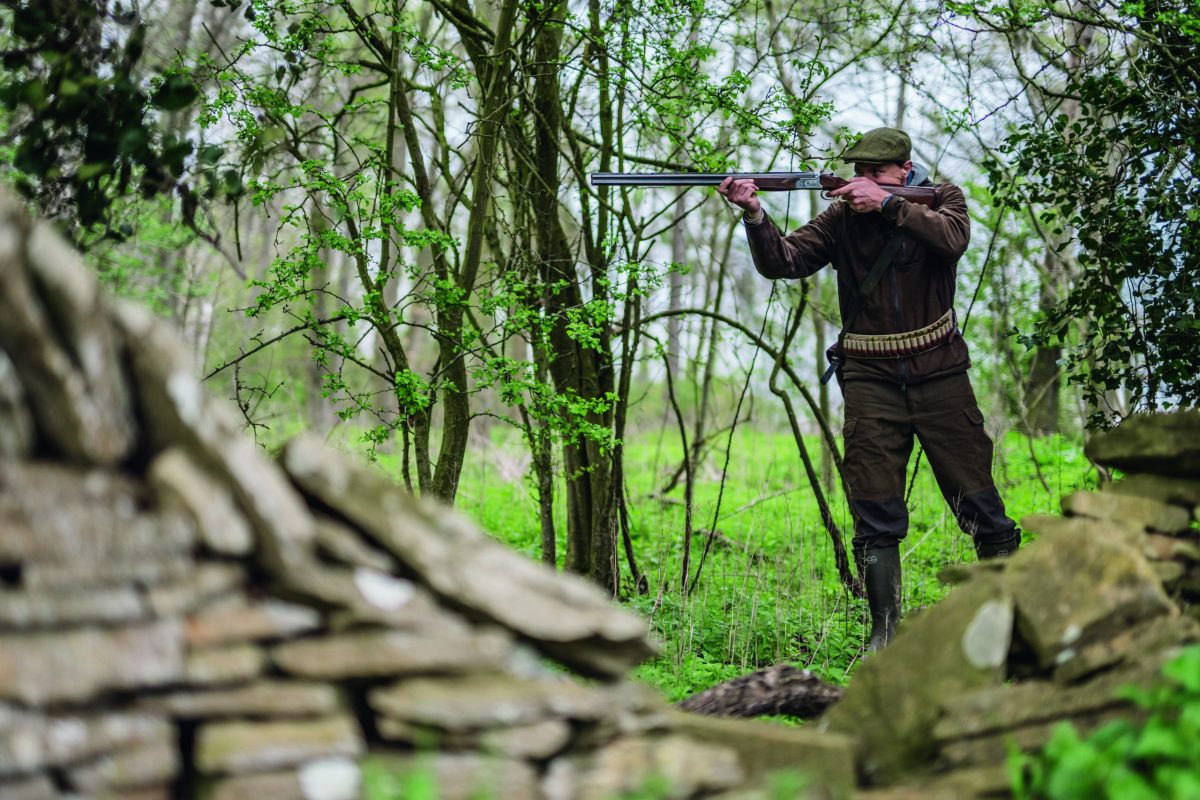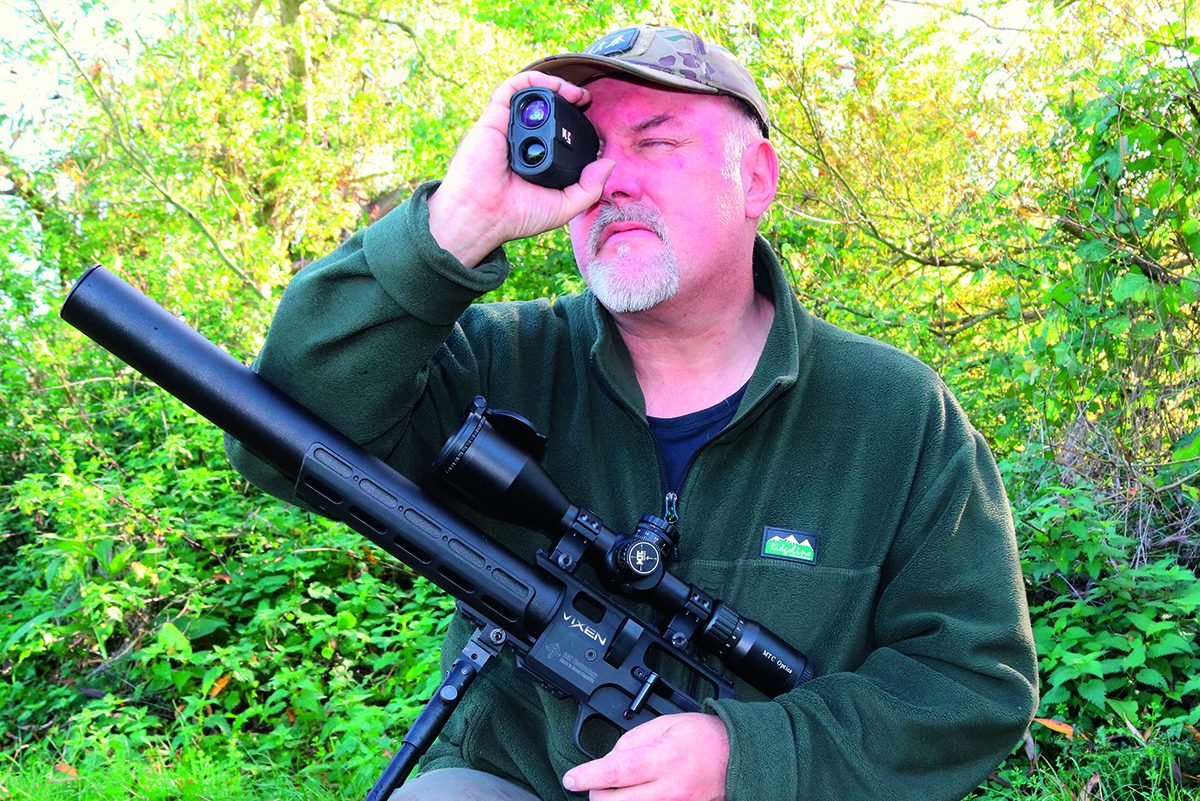Hunting rabbits with thermal optics
A switch to thermal gear helps Mat Manning bring some tricky bunnies to book during a nocturnal foray
After an alarming slump over the past couple of years, the rabbits in my locality are making a very healthy comeback. I’m delighted to see them around again, but several landowners are less pleased because the burrowing animals are causing them serious problems – so serious, in fact, that I am now extending my pest control rounds into the night.
Following the decline in rabbit numbers resulting from viral haemorrhagic disease (VHD), there was little need to keep this agricultural pest in check because there weren’t enough to do any great harm.

Mat steadies himself for a well-earned shot after creeping within range of his unsuspecting quarry
Hunting rabbits with thermal optics
It’s a very different story now though, as populations on some farms are now significantly larger than they were before VHD arrived on the scene. The influx of bunnies is causing damage on several fronts. On one estate they are nibbling young trees and munching through grass and vegetable crops, but it’s their burrowing that is causing most concern on the farm where I am shooting tonight. (Read how deep is a rabbit hole.)
Rabbit holes are a hazard to livestock that can break a leg if a foot goes down a burrow. For this reason, the majority of the rabbit control I do these days tends to be around horse and pony paddocks. It’s a handy coincidence that rabbit meat is lean, healthy and very tasty, so my efforts are rewarded with meat for the freezer when all goes to plan.
This particular permission is not particularly large, but the rabbits seem to really like the sandy soil and there are abundant signs of their digging and scraping. I made some good bags here in daylight, mostly during the last couple of hours before sunset, through late spring and summer, and the numbers are now down to a noticeably lower level.
The population is still sufficient to do serious damage, so I am still making regular visits hunting rabbits. Things have changed though and the rabbits have grown far more wary, so it now requires a nocturnal approach to ensure decent results.
Lamping gear
The kit you choose to use for after-dark hunting rabbits will depend very much on your budget. Lamping gear is the most affordable; you can pick up a decent setup for around £100 and you will shoot rabbits with it. Of course the downside of lamping is that rabbits eventually learn to associate the beam of your light with danger. Coloured filters can help by changing and softening the glow, but your quarry will always see you coming when you’re using a conventional lamp.
My first choice for nocturnal trips hunting rabbits these days tends to be a digital infrared optic. This lamp-free kit is stealthy, relatively affordable, fairly simple to use and produces a good image that not only facilitates clear quarry identification, but also gives you a reasonable view of what is behind your target.

A headlamp is useful for hunting with a thermal sight – not just for loading, but also for finding your way around
But on this trip I decided to swap my usual infrared setup for the InfiRay Tube TL35 thermal gunsight. Although not cheap, thermal imagers combine awesome stealth with excellent viewing. They don’t use any illumination that could blow your cover, and being able to see your quarry’s heat signature means it’s often possible to spot critters that would otherwise have been obscured by undergrowth.
Most readers will know that I am a big fan of FAC-rated airguns, especially when it comes to targeting wary rabbits. However, because this particular permission is quite small, and because thermal imagers don’t always provide the clearest view of what is behind your target, I decided on the safer option and coupled the Tube with my sub-12 Weihrauch HW100 BP.
It makes for a great combo and I didn’t feel that the lower-powered gun would be too much of a compromise in the windless conditions. In fact, the sub-12 BP’s whisper-quiet muzzle report was likely to be a serious advantage.
My usual approach hunting rabbits with thermal optics is to wait until a couple of hours after nightfall to ensure that the rabbits are well out in the fields rather than just in the margins.
However, owing to a very early start the following morning, I was unable to leave it as late for hunting rabbits as usual and arrived just as the last of the evening light was disappearing. It was sufficiently dark for me to be unable to see whether there were any bunnies out in the fields, so I couldn’t wait to have a look through the Tube.

The edge provided by using a thermal riflescope enabled Mat to make a decent bag of bunnies in some fairly tough conditions
It was also sufficiently dark for me to need my headlamp in order to see what I was doing when loading the HW’s magazine with fiddly little .177 pellets. Having a light source close to hand, or attached to your head, is an important thing anyone heading out shooting with thermal kit needs to remember. High-tech thermal optics are great for spotting and shooting quarry, but they aren’t very helpful when you need to clamber over gates or through treacherous terrain.
The InfiRay Tube has a lot of great features, but one of the simplest and most useful is its zoom function. Full magnification is a generous 12x and there is also a picture-in-picture mode if you need to give it a further boost for long-range shots. While that magnification is useful for precise pellet placement, being able to wind it down to just 3x is extremely handy when it comes to spotting quarry.
You can turn it down on the fly by winding the top turret anticlockwise (and back up by turning it clockwise) and the increased field of view provided on low zoom makes easy work of scanning the fields.
My first peep through the Tube on this occasion revealed quite a sight. In a field where I might expect to see three or four rabbits in daylight there were well over a dozen bunnies out gobbling grass under the cover of darkness. I grabbed a quick snap through the unit’s built-in camera and managed to capture eight in a single shot!
Encouraging as the sight was, the closest of those rabbits was probably about 100m away and I needed to get a lot closer to think about taking a shot – not an easy task on a still, windless evening.
Fortunately, there is a fairly busy road about half a mile from this farm and the distant drone of cars did provide some ambient noise to mask the sound of my approach.
Treading as lightly as I could, but still aware of the dew-drenched grass squeaking quietly beneath my boots, I made slow progress towards the rabbits. I always try to keep count of my steps in situations like this when I can’t see my quarry as it gives me some idea of how far I have closed in.
At 50 paces I stopped for another look through the Tube and was delighted to see that the rabbits were still out and appeared to be unaware of my presence. They were still out of range – especially as I was shooting without a rest – so I decided to continue for another 20 paces.
This final part of the stalk was slow, and I settled to my knees in readiness for the shot even before confirming that the rabbits were still out.

A rabbit’s heat signature is framed on the Tube’s display as Mat rings the crosshairs to rest
A scan through the Tube confirmed that there were indeed a few remaining rabbits above ground and the closest one was comfortably within range. I wound up the magnification, steadied my breathing, pushed off the safety and settled the crosshairs on the unsuspecting bunny’s head before touching off the trigger.
The “pap” from the Weihrauch’s silenced muzzle was barely audible, but the crack of the impacting pellet rang out through the still night air.
The rabbit flipped before landing lifeless on the short grass and its startled mates did a disappearing act before I even had time to cycle another pellet into the breech.
Delighted to have accounted for the first rabbit of the night, I checked the rest of the field through the Tube to confirm that there were no others above ground and then switched on my headlamp before walking in to make the retrieve.
The rabbit was cleanly shot through the head, as intended, and I gave it a thorough squeeze down the belly to empty its bladder before slipping it into my bag.
With the headlamp switched off again there was just about enough ambient light from the moon and stars for me to be able to make my way along the hedgerow and towards the next field. Before passing through the gateway I stopped for a quick scan along the other side of the fence, and I’m glad I did as there were two rabbits out about 30m away on the opposite side.
It’s always worth checking what’s on the other side of fences and gates before going through or climbing over, and in this instance it earned me a very easy shot. Using the post for support, I soon had the crosshairs fixed on the head of the closest rabbit before rolling it over with a wallop to the skull. Predictably, the other rabbit bolted for cover, but at least I’d managed to account for one of them.
Over the next couple of hours I managed to bag a total of six rabbits. I always enjoy my after-dark hunting and I am sure that the extra stealth and vision provided by the switch to thermal optics helped me to make the best of a tricky situation.








